Sourdough Kouign-Amann
Sourdough Kouign-Amann is a crisp, buttery, sweet and delicious treat made with layers of fermented dough, butter and sugar. No exaggeration, this might be the most delicious pastry I’ve ever tasted.
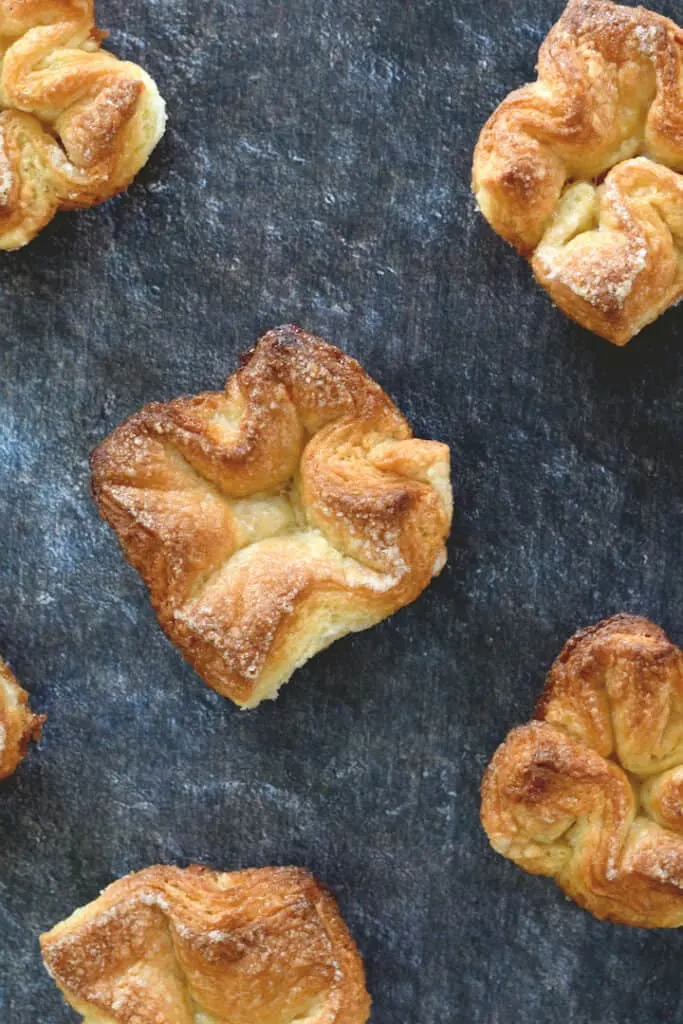
Have you ever heard of Kouign-Amann? This French pastry is a real gem. The name comes from the Breton words for cake (kouign) and butter (amann). I mean, seriously, how could that not be heavenly?
Kouign-Amann is a so-called “laminated” dough. What’s a laminated dough?
Take a big block of solid butter (yum!) and wrap it with pastry dough. Then roll, fold, roll, fold, creating layers of dough separated by the butter. Croissants, Puff Pastry and Danish pastry are also made with laminated dough.
Want to make a good thing even better? As we sourdough bakers know, wild yeast does good things for the flavor of any baked good. Kouign-Amann is no exception to that rule.
If you don’t already have one, I can show you how to make a sourdough starter and how to feed a sourdough starter.
What if you don’t have a starter ready yet? No problem, you can make this Kouign-Amann recipe using commercial yeast.
Ingredients
- Active sourdough starter
- Water
- All purpose flour
- Table salt
- Granulated sugar
- Salted European Butter
How to make Sourdough Kouign-Amann:
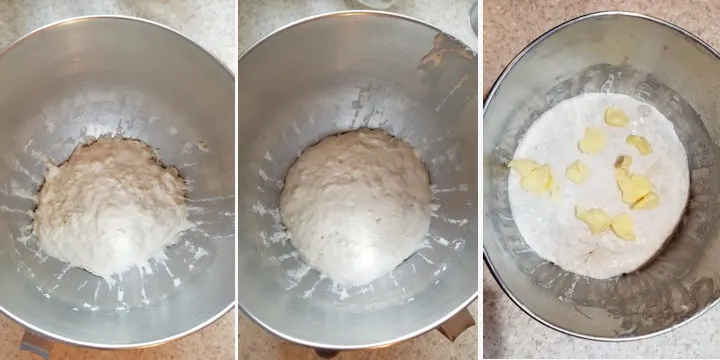
- Combine the starter with water and some of the flour and set aside for 30-60 minutes.
- Add the sugar, salt and butter to finish mixing the dough.
- The dough will take 3-5 hours to ferment.
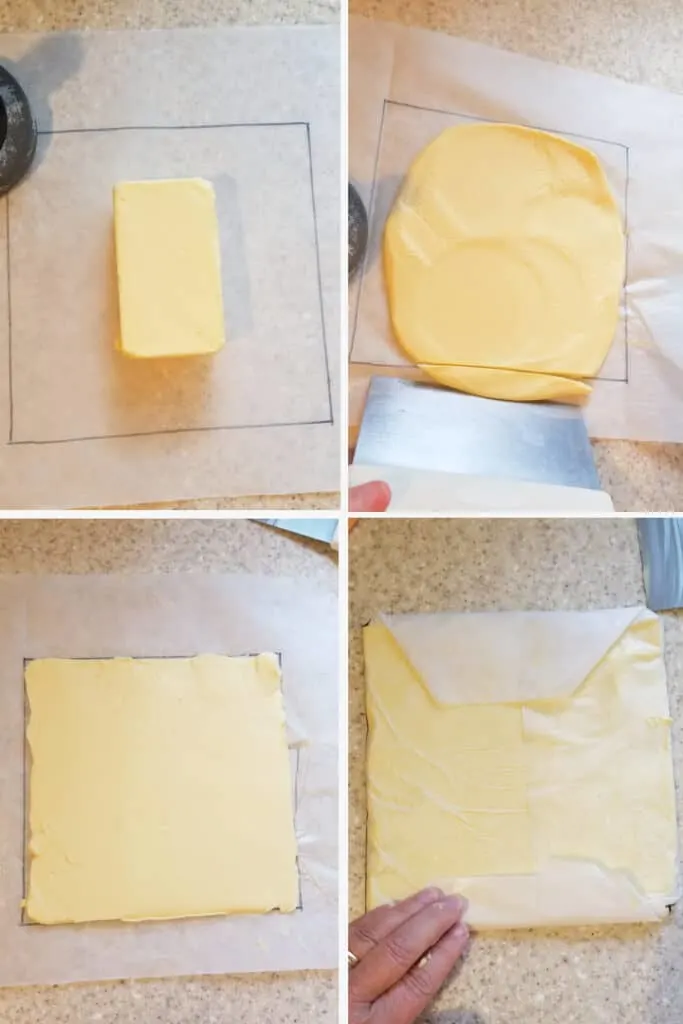
- While the dough ferments, make the butter packet
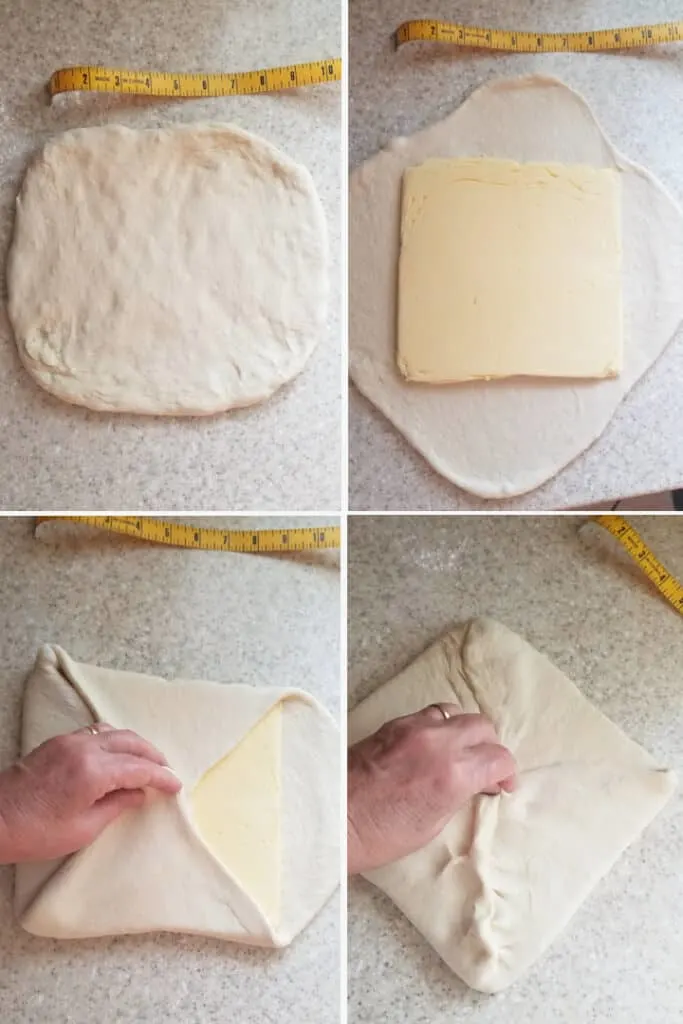
- Pat the sourdough to a 10″ square.
- Make four flaps from the sides and set the butter packet in the center.
- Fold the flaps over the butter.
- Pinch the seams and pat the dough flat.
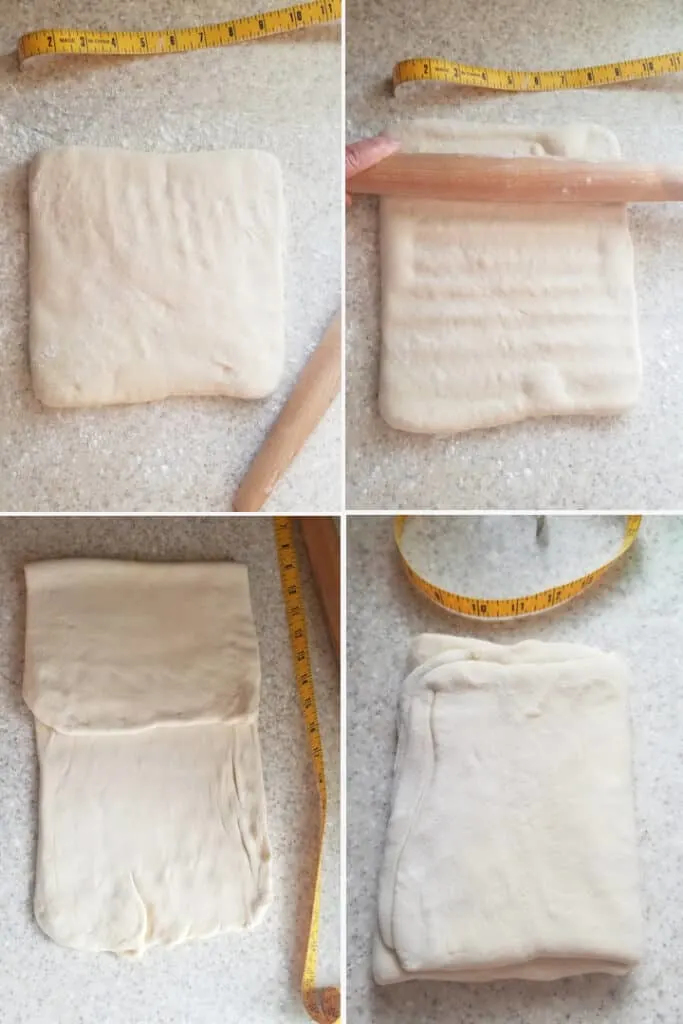
- Set the dough onto a lightly floured surface.
- Use the rolling pin to press on the dough before rolling.
- Fold the dough like a letter.
- Repeat for a second “turn”.
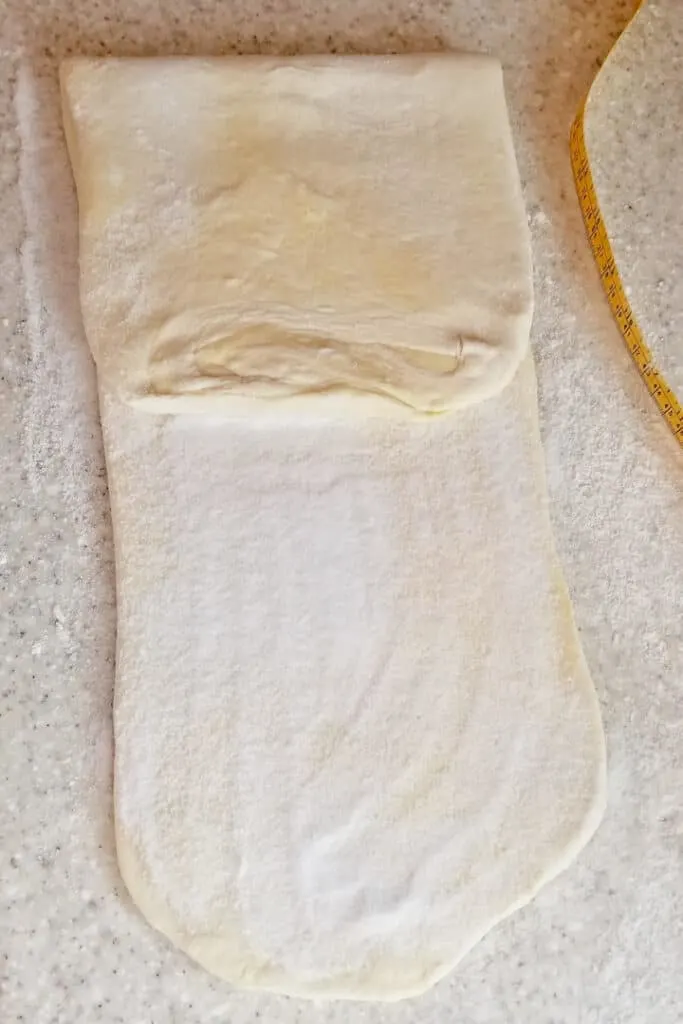
- Do two more turns like the first two, adding a layer of sugar before folding.
How to shape individual Sourdough Kouign-Amann:
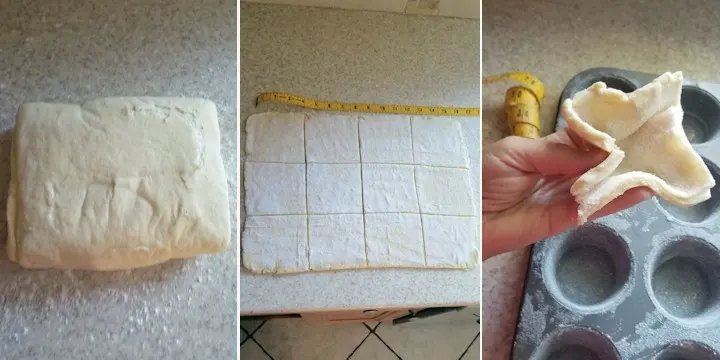
- Chill the dough overnight.
- Roll to a 12″x 16″ rectangle, sprinkle with sugar and cut into 4″ squares.
- Pinch the sides of the squares to form the Kouign-Amann and set into the prepared pan.
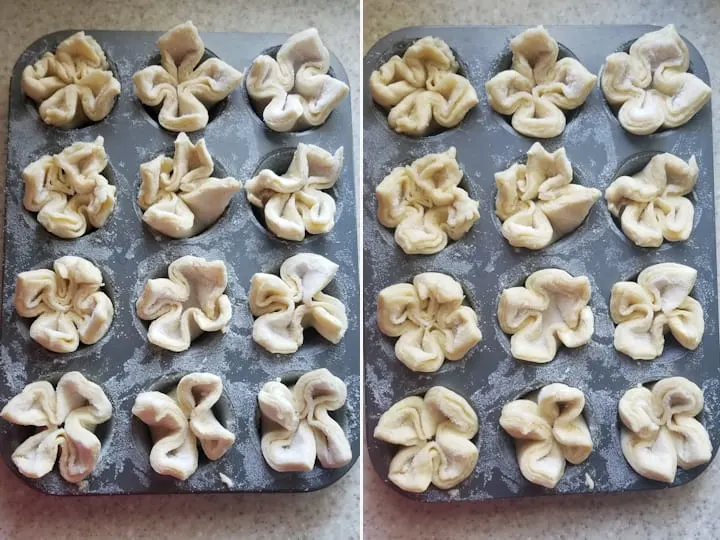
- Set the pastries aside to rise.
- They won’t double, but should puff and fill the cups.

- Remove the Kouign-Amann from the pans immediately or they will stick.
- Cool upside down.
How to make a Sourdough Kouign-Amann Cake:
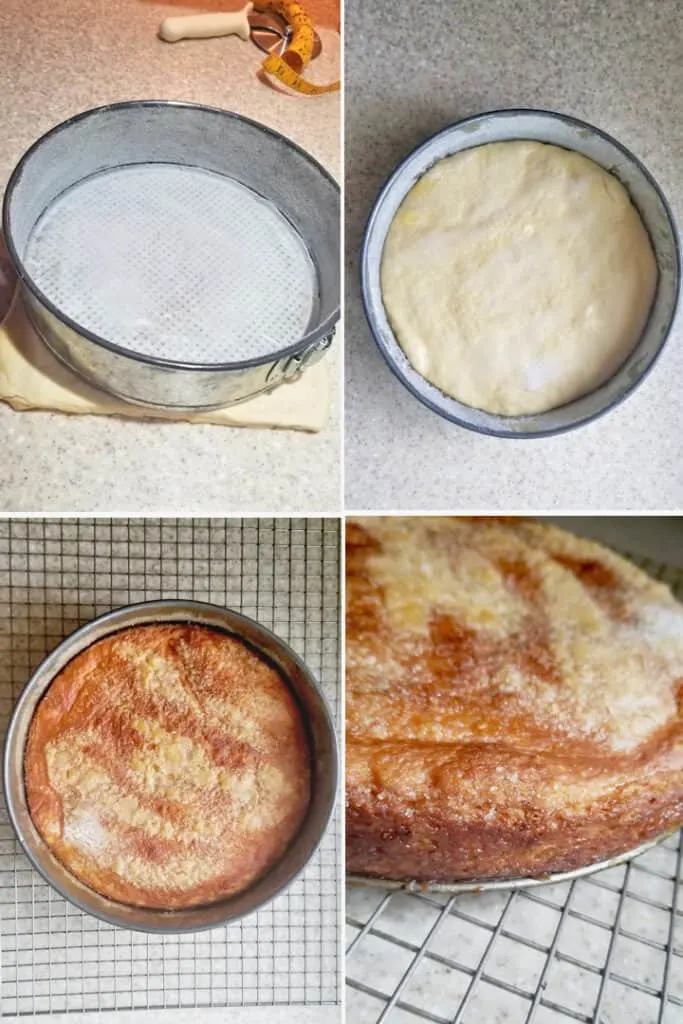
- Roll the chilled sourdough to a 10″ square.
- Trim off the corners and fit the dough into the prepared springform pan. Set aside to rise.
- Bake 45-50 minutes.
- Immediately release the cake from the pan and cool before serving.
FAQs about Sourdough Kouign Amann:
I made this recipe using both American and European butter. You will get good results with either type of butter. The European butter is a little easier for laminating since it is less brittle than American butter.
I use unsalted butter for virtually all of my baking. But for this recipe I recommend using salted butter. The salt balances out the sweetness of the caramelized sugar. If you use unsalted butter I recommend you sprinkle a 1/2 teaspoon of salt over the butter packet before laminating the dough.
Sourdough Kouign-Amann can be kept at room temperature for 1-2 days, but is best the day it is baked.
Yes, they freeze beautifully.
After a day at room temperature, or after freezing, the best way to revive the texture of the Sourdough Kouign-Amann is to warm it in a 200°F oven for 5-10 minutes.
Absolutely! Visit this post for a Kouign-Amann recipe using yeast.
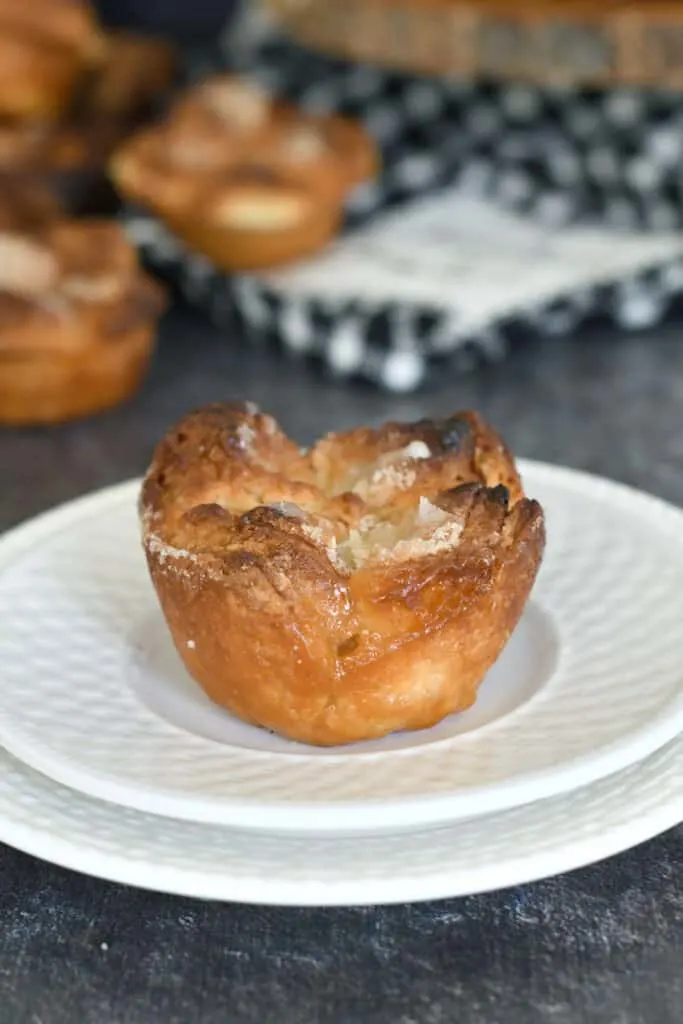

If you love classic French pastries (and I know you do), here are a few great recipes you’ll want to try; Caneles de Bordeaux, Sourdough Baba Au Rhum, Marjolaine, Classic Cream Puffs, Chocolate Eclairs, French Apple Tart, Creme Brulee, and airy Chocolate Genoise.
I know you hate to throw away that sourdough discard. Check out these recipes that use sourdough discard.
If you love this recipe as much as I do, I’d really appreciate a star rating and a quick comment. Ratings and comments help my recipes show in search results. Thanks!
Sourdough Kouign-Amann Recipe
Ingredients
Dough
- 8 ounces active sourdough starter (1 cup)
- 2 ounces water (¼ cup warmed to 110 °F)
- 6 ¼ ounces all purpose flour (1 ¼ cups, see note)
- 1 teaspoon table salt
- ¾ ounce granulated sugar (1 ½ tablespoons)
- 1 ounces salted European butter (room temperature)
Laminating
- 8 ounces salted European butter (room temperature)
- 8 ounces granulated sugar (1 cup)
Instructions
Dough
- In the bowl of a stand mixer or a large mixing bowl combine the starter with the water and ½ cup of the flour. Mix for 30 seconds to combine the ingredients. Cover the bowl and set aside for 30-60 minutes.8 ounces active sourdough starter, 2 ounces water, 6 ¼ ounces all purpose flour
- With the mixer running on low add the salt, sugar and toss in the softened butter. Switch to the dough hook. Add the remaining ¾ cup of flour and knead on medium for 5 minutes. The dough should clear the sides of the bowl and cling to the hook. If working by hand finish adding the flour by hand and knead for 5 minutes.1 teaspoon table salt, ¾ ounce granulated sugar, 1 ounces salted European butter
- Transfer the dough to a lightly oiled bowl, turning once to coat the dough. Cover the bowl and set it aside at room temperature. After 30 minutes uncover the bowl, lift one side of the dough over into the middle of the dough. Repeat with the other three sides of the dough then flip the dough over. Cover the bowl and after 30 minutes repeat the procedure. Cover the bowl and after 60 minutes repeat the procedure. Cover the bowl and after 60 minutes repeat the procedure one last time. By now the dough should be lively, elastic and airy. If the dough is still sluggish give it another hour or two at room temperature.
- Meanwhile, prepare the butter packet.
Butter Packet
- Draw an 8" square in the center a ½ sheet size parchment paper. Flip the paper over so the ink is on the back.
- Place the butter in the middle of the square. Fold the parchment over the butter. Use a rolling pin or other heavy object (I use the flat side of a meat tenderizer) to flatten the butter to fill the 8"x 8" square. You can lift the paper if it sticks. Trim and rearrange the edges of the butter as needed. Fold the butter into the parchment and place in the refrigerator. The butter should be firm and cool but a little flexible for layering into the dough.8 ounces salted European butter
Laminate
- Turn the dough out onto a lightly floured surface. Do not knead out the air. Use your hands to pat the dough into a 10" square. Pull from each of the four sides to form a flap of the dough, leaving the center thicker than the flaps. You should end up with a square with four "flaps" coming out from the sides.
- Unwrap the butter packet and place it in the middle of the square. Fold the flaps so they overlap and enclose the butter, pinching the corners as necessary to glue the seams together. You should now have an 8" square of dough with the butter enclosed.
- Use the rolling pin to gently press on the square to flatten it. Roll the dough to a 8" x 24" rectangle. Take your time to roll gently and evenly so the butter stays in one layer in the dough.
- Orient the dough so the long side of the rectangle is facing you. Brush off any excess flour. Fold the right ⅓ of the dough towards the middle then fold the left ⅓ of dough over enclosing it like a letter. This is the first "turn". At this point if the dough is very tight or the butter is soft, refrigerate for 30 minutes. If the dough is still easy to work and the butter is cold go ahead with the next step.
- Orient the dough so the closed edge is on the top side and the open edge is facing you. Roll the dough again to an 8" x 24" rectangle. Brush off any excess flour and again fold the dough like a letter. This is the second "turn". Set the dough on a sheet pan, cover with plastic and refrigerate at least 30 minutes.
- Remove the dough from the refrigerator. On a lightly floured work surface roll the dough to an 8" x 24" rectangle. Sprinkle ⅓ cup of the granulated sugar evenly over the dough. Fold the dough like a letter. At this point if the dough is very tight or the butter is soft, refrigerate for 30 minutes. If the dough is still easy to work and the butter is cold go ahead with the next step.8 ounces granulated sugar
- Remove the dough from the refrigerator. Roll the dough to an 8" x 24" rectangle. Sprinkle ⅓ cup of the granulated sugar evenly over the dough. Fold the dough like a letter. Wrap the dough and place it in the refrigerator for at least 2 hours or up to a day. I like to leave it overnight and finish making the pastries in the morning.
Assembly
- Generously butter a 10” round springform cake pan and line the bottom with a round of parchment OR butter a 6 cup jumbo muffin pan OR a 12 cup standard muffin pan. Dust with sugar to coat. Shake out any excess.
- If using a 10” round pan, roll the dough to a 10" square and trim the corners to make a 10" round. Set it into the pan. Sprinkle 2 tablespoons of sugar over the dough. Cover the pan and leave the dough to rise for 1½-2 hours. (The dough scraps can be formed into a loose round and baked as a treat for the chef.)
- If using a jumbo muffin pan, lightly sprinkle the work surface with granulated sugar and roll the dough out to an 15" x 10" rectangle. Sprinkle 2 tablespoons of sugar over the top of the dough and pat it in with your hands. Use a pizza cutter or sharp knife to cut the dough into a 3×2 grid. You will now have six 5" squares.
- If using a standard muffin pan, lightly sprinkle the work surface with granulated sugar and roll the dough out to a 16" x 12" rectangle. Sprinkle 2 tablespoons of sugar over the top of the dough and pat it in with your hands. Use a pizza cutter or sharp knife to cut the dough into a 3×4 grid. You will now have twelve 4" squares.
- Grasp the 4 sides of a square and bring them together in the center. Set the dough into a muffin cup with the points up (see photo). Repeat with the other squares. Cover the tray and leave it to rise for 1½ hours. The pastries will not double in size but should come to room temperature and puff up a bit to fill the pan.
- Meanwhile, preheat the oven to 375 °F (350 °F for 10" cake). Place a sheet of aluminum foil on the bottom rack of the oven to catch butter and sugar overflow.
- Bake the pastries until deeply browned, about 30 minutes minutes for standard muffins, 35 minutes for jumbo muffins and 45-50 minutes for a 10" round. When you press on the center of the 10" round it should be quite firm.
- As soon as they come out of the oven, flip the pan to release the pastries onto a cooling rack. If you find the muffins in the center cups of the pan are not well browned on the bottom, put them back into the pan and bake for another 5-7 minutes. Allow them to cool completely upside-down. For the 10" pan, as soon as the cake comes out of the oven run a paring knife around the sides and release the sides of the pan. Cool completely before removing the bottom of the pan.
Would you like to save this recipe?
As an Amazon Associate and member of other affiliate programs, I earn from qualifying purchases.












Hi there!
I tried to make a different recipe for this and it was an unmitigated disaster 🙁
Am willing to give it another go using yours, but just read through it again and I see 5 turns, with 2 of them including 1/3 c of sugar. Is the last 1/3 cup reserved for the final bake or are there 6 turns total (3 without sugar, 3 with)?
Thank you so much and I look forward to using your recipe – just don’t want another sad day!
@Cynthia,
Sorry I meant yours reads as 4 turns, 2 without sugar and 2 with.
Hi Cynthia, yes, you are doing a total of 4 turns. The first two turns without sugar and the second two turns with sugar, each with 1/3 cup of sugar. The last 1/3 cup of sugar is used to coat the baking pan, roll the dough and sprinkle the pastry once it’s in the pan. What happened with your first try that it was such a disaster? Where did it go wrong?
@Eileen Gray,
I think I shattered the butter on the first turn. :(. Mistake number 1
Then I held it too long in fridge. Mistake number 2
Then I didn’t flip them out of the pan fast enough. Mistake number 3
It’s ok, baking is an adventure, sometimes things go wrong, you learn and try, try again 🙂
Good luck!
I’m working on this today. (I bake sourdough almost daily). I am finding this dough quite stiff, even after mixing, and after the first 30 mins fermenting. My starter was beautifully risen, and I’m using weight not volume measurements. Is it supposed to be a very stiff shaggy dough?
After reading your comment I went back over the recipe and also the yeasted Kouign-Amann. I realize I made a mistake in the flour amount for the sourdough version. Sorry, it should be 1 1/4 cups flour, not 1 1/2. If you’ve already made the dough you can add 2 tablespoons of water to the dough to get it closer to the proper hydration. I’ve fixed the recipe card. Thanks for bringing it to my attention. As many times as I test the recipes mistakes sometimes slip through.
@Eileen Gray, ok I’m not crazy after all. I took screenshots of the recipe this morning and it says 1.5 c, now it says 1.25. Thank you for clarifying for sure. I already had it fermenting bc I wasn’t sure of proper dough consistency, so I squished as much water as I could into it in the first hour or so, though I didn’t actually measure it. I upped the temp on my proofer to ferment quicker bc of the water squishing and I hope it puffed up *enough*. Should have refrigerated before patting it out for butter insertion. It’s resting in the fridge now before I do all the turns. It’s my first try at this so here’s hoping. For sure will try again bc I have a healthy strong vigorous starter and would love to use it in these pastries, and your recipe seemed quite approachable. It won’t be a Dominique Ansel pastry, I just want a sweet sourdough edible!
Luckily, it’s a pretty forgiving pastry. Because you’re going to roll and fold it several times the water should have a chance to disperse.
@Eileen Gray,
In the Dough step 2, you say add remaining cup of flour, but it should be 3/4 cup
Thanks for pointing that out. It’s been fixed.
am I missing where the cup of sugar plays into the butter layer?
The sugar is sprinkled onto the dough during the last folds of the laminating process. I guess it’s not really part of the “butter” layer. I’ve reworded the text in the recipe.
So so gut, vielen Dank, das sie das Rezept auch in Gramm Angaben teilen!
Viele Grüße sendet,
Jesse-Gabriel aus Berlin
Please let us know how to say it. No sense making it if you can’t tell people what it is! They have it at my local bakery so I know it is not pronounced AT ALL how it is spelled.
Certainly folks can google to see how to pronounce it. I say it as “queen a mahn”.
We could Google it but we are here to learn ALL from you. Thank you!
Even knowing how it’s supposed to be pronounced, I still find myself stumbling over it as it comes out of my mouth.